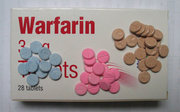Clinical Question: Is warfarin (Coumadin) better than aspirin for the treatment of patients with intracranial arterial stenosis?
Setting: Outpatient (any)
Study Design: Randomized controlled trial (double-blinded)
Allocation: Concealed
Synopsis: Results of retrospective studies suggest that warfarin may be more effective than aspirin at preventing stroke in patients with intracranial arterial stenosis. However, these studies may be biased by poor ascertainment of outcomes and limited follow-up; that is, if patients who die because of warfarin complications are not identified, the drug may seem safer and more effective than it actually is. This study is the largest and best to date to address this question.
The investigators enrolled adults 40 years and older who had experienced a transient ischemic attack or nondisabling stroke in the previous 90 days and had a 50 to 99 percent stenosis of the internal carotid, middle cerebral, vertebral, or basilar arteries. They excluded patients with atrial fibrillation, major comorbidities, or significant stenosis of the extracranial carotid artery.
The mean age of participants was 63 years; 61 percent were men, and 58 percent were white. The most common lesion was middle cerebral (32 percent of all obstructions). Approximately 20 percent of patients had internal carotid, vertebral, or basilar artery lesions, and 6 percent had multiple lesions. One half of patients had a 50 to 69 percent stenosis and slightly more than one third had a 70 to 99 percent stenosis. Patients were assigned randomly to receive warfarin with a target International Normalized Ratio of 2.0 to 3.0 or aspirin in a dosage of 650 mg twice daily. If patients had dyspepsia, the dosage of aspirin could be lowered (minimum: 325 mg once daily). Groups were balanced at baseline, outcomes were assessed blindly, and analysis was by intention to treat.
Although investigators planned to follow patients for a mean of 36 months, the study was stopped prematurely by the safety committee. After a mean follow-up of 1.8 years, it was clear that patients receiving warfarin were more likely to die (9.7 versus 4.3 percent; P = .02; number needed to treat to harm [NNH] = 18 for 1.8 years; 95% confidence interval [CI], 10 to 84). There also were more major hemorrhages in the warfarin group (8.3 versus 3.2 percent; P = .01; NNH = 20 for 1.8 years; 95% CI 11 to 80).
Bottom Line: Warfarin instead of aspirin causes one extra death every two years for patients with intracranial arterial stenosis and a recent stroke or transient ischemic attack. Given the risk and cost of the imaging studies used to diagnose intracranial arterial stenosis, perhaps prescribing 650 mg of aspirin twice a day for these patients is the better option. (Level of Evidence: 1b)
MARK EBELL, M.D., M.S.
Study Reference: Chimowitz MI, et al., and the Warfarin-Aspirin Symptomatic Intracranial Disease Trial Investigators. Comparison of warfarin and aspirin for symptomatic intracranial arterial stenosis. N Engl J Med March 31, 2005;352:1305-16.
Used with permission from Ebell M. Warfarin increases mortality in intracranial arterial stenosis. Accessed online June 1, 2005, at: http://www.InfoPOEMs.com.
COPYRIGHT 2005 American Academy of Family Physicians
COPYRIGHT 2005 Gale Group



